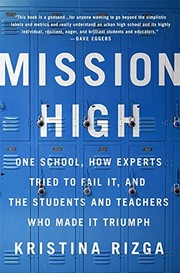293 pages
English language
Published Nov. 8, 2015
one school, how experts tried to fail it, and the students and teachers who made it triumph

293 pages
English language
Published Nov. 8, 2015
"It's easier for a journalist to embed with the Army than to go behind the scenes at an American public school. Kristina Rizga spent an unprecedented four years reporting from the classrooms and hallways of Mission High School in San Francisco. The result is Mission High, a first hand report from inside a "low-performing" school whose students are, in fact, thriving. Rizga expected noisy classrooms, hallway fights, and disgruntled staff. Instead, she found a welcoming place; satisfied students, teachers and parents; plummeting dropout rates; and a diverse student body with an 88% college acceptance rate. By closely following the individual lives of students and teachers, Rizga illustrates the invisible structures, essential ingredients, and specialized skills that drive genuine academic achievement. Mission High shows how the alternative, hyper-local and progressive approach of Mission High School works. In providing context for the success of Mission High, Rizga explores the most contentious issues …
"It's easier for a journalist to embed with the Army than to go behind the scenes at an American public school. Kristina Rizga spent an unprecedented four years reporting from the classrooms and hallways of Mission High School in San Francisco. The result is Mission High, a first hand report from inside a "low-performing" school whose students are, in fact, thriving. Rizga expected noisy classrooms, hallway fights, and disgruntled staff. Instead, she found a welcoming place; satisfied students, teachers and parents; plummeting dropout rates; and a diverse student body with an 88% college acceptance rate. By closely following the individual lives of students and teachers, Rizga illustrates the invisible structures, essential ingredients, and specialized skills that drive genuine academic achievement. Mission High shows how the alternative, hyper-local and progressive approach of Mission High School works. In providing context for the success of Mission High, Rizga explores the most contentious issues surrounding education in America. She argues that attentive, conceptually driven teaching can lead to learning regardless of socio-economic background, and that mixing high-achieving students and underachieving students benefits both groups. She shows how the focus on standardized test scores can't fix America's education system, because the most important data lives at the individual classroom level-where positive outcomes depend on the cooperation between students and teachers. In tracking Mission High's students through college, Rizga provides a model for the future of education in America and shows how we all benefit from the kind of engaged learners, innovators, independent thinkers, and compassionate citizens that can emerge from the public school system. "--